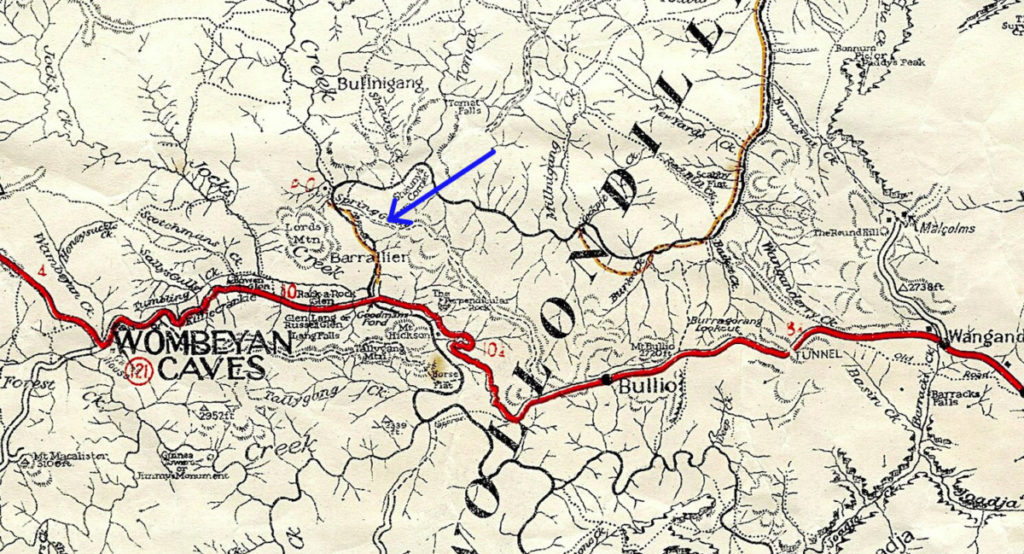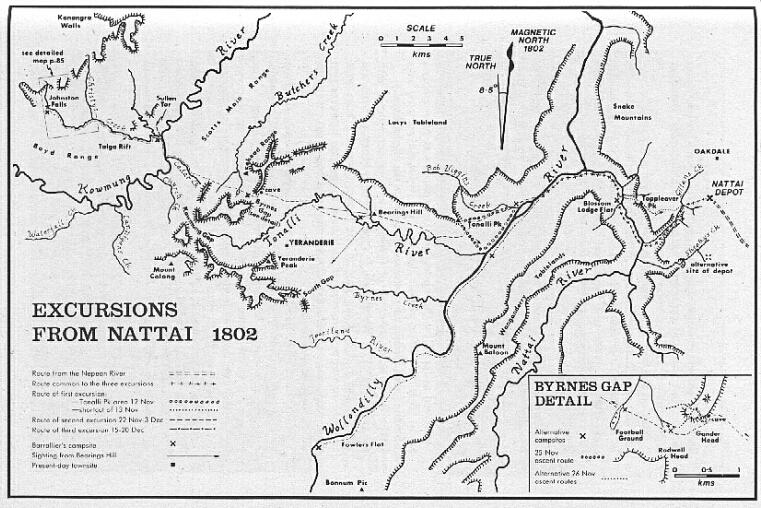As always, we welcome any corrections, additional information and suggestions! Our thanks to Robert Geddes for his contributions to the postal history.
From 1915 onward Yerranderie and surrounding lands to the south were referred to as being in the “Barrallier Region”. There was a village 22 kilometres to the south west named Barrallier which had a post office.
The last newspaper reference we have found which describes Yerranderie as part of the Barrallier region was in the Goulburn Evening Post in 1951 with a short article on the sale of the Silver Mines’ Hotel in Yerranderie and the transfer of it’s licence to St Marys in Western Sydney. Most references to the Barrallier Region seem to have faded out during the 1950s.
But first – How did the Barrallier Region come into being?
It looks like the name of the Barrallier Village and Region came into being as a result of a disgruntled farmer named Hughes.
Until 1925 the area was called Talloweena which centred on the spot where the Murruin Creek flows into the Wollondilly River and is the site of an old ford on the Wollondilly. It is downstream from Goodman’s Ford and was the location of the Talloweena Receiving Office established on the 1st March 1909, Mrs Kate Alders was appointed Receiving Office Keeper. On Google maps the site comes up with the marker label “Wonga”

It seems that the owner of the Talloweena Station, a few miles downstream took offence at the post office having the same name…..
The name was changed to Barrallier on the 1st December 1915
The Camden News reported on the 2nd March 1916:
“The name of the Talloweena Post Office and district has recently been, changed to Barrallier…. [The] post office’ and district which is situated on the Wollondilly River between Mittagong and the Wombeyan Caves. The owner of Talloweena, Mr Hughes (evidently of a tenacious nature like his namesake. (William Rex.), objected, and the postal authorities re named the office Barrallier, after the explorer, a young French lieutenant, who discovered the locality.”
The Sydney Daily Telegraph on October 14th 1922 reported:
“Talloweena” is the homestead of a local grazier…. The [post] office, however, was established a couple of miles higher up the river, and was [also] called Talloweena. The owner of Talloweena homestead refused to patronise it and went over the river and ten miles to the [Wombeyan] caves to get his mail, which was addressed “Talloweena, Wombeyan Caves” and was very often delayed by being first sent to, and returned from Talloweena.
A Telephone Office was established at the Receiving Office 20 August 1925 and it was raised to Post Office status on the 1st January 1927 and Vincent Joseph Carlon was Postmaster.
Why did the references to Barrallier disappear?
The Barrallier Post Office was closed on the 5 April 1971 and we can assume that the construction of Warragamba Dam was a precursor to the slowdown of postal activity and eventual closure.
The Barrallier Post Office had a telephone exchange and weather station. Newspaper readers from the surrounding areas to the east were encouraged to ring the Post office to get details of the river crossing before travelling to the Wombeyan Caves. The rain and temperature data were occasionally quoted in the local newspapers in surrounding areas. The last of such reports which we can find that specifically refers to the Barrallier Post Office is from The Southern Mail (Bowral) on the 15th Feb 1946. in the Southern Mail in October 1953 there is a rain report from Barrallier.
The Upper Burragorang Post Office closed in 1931 as was reported in the Goulburn Evening Penny Post on the 27th May 1931. It is a reasonable assumption that after this closure, the Barrallier Post Office handled mail services for a fairly large chunk of the Southern Burragorang which would have accounted for Yerranderie being included as part of the Barrallier Region
References to the Barrallier Post Office started to fade in the late 1940s which was the early days of the construction of the Warragamba Dam. A proportion of the Barrallier Post office services would have been provided to the now flooded southern part of the Burragorang Valley. Clients would have been moving away during the 1950s and the need for postal services decreasing.
Here is the list of postal routes and contractors from1910 for Barrallier and the Burragorang Valley. Yerranderie, Burragorang listed as contracts 60 & 61 and Barrallier (as Talloweena) is contract 37 on page 2.
If anyone has more information…. please let us know.
So, who is Francis Louis Barrallier?
Francis Louis Barrallier (1773-1853) was a French engineer who, after the siege of Toulon in 1793 was employed by the British who had captured the Port. By 1799 he had established a good reputation with the British and was touted for the post of deputy surveyor general of New South Wales. The British Secretary of State refused to appointment him to this role, most likely as a result of his non British ancestry. He was, however allowed to accompany the new NSW governor, Philip Gidley King to the colony, arriving in Sydney on 15 April 1800. King employed him as an architect.
As a result of a lack of commissioned officers available for duty in the Colony, Governor King appointed Barrallier as an ensign in the New South Wales Corps but due to the very slow communications between Britain and NSW there was a lengthy period before this appointment was confirmed. During this time Barrallier began to make his name as a surveyor and explorer. In March 1801 he surveyed the South Eastern Coast of Australia and mapped it between Wilson’s Promontory and Western Port. In July 1801 he surveyed Newcastle Harbour.
On the 23 August 1801 Governor King appointed him acting engineer and artillery officer which involved him in the upgrades and maintenance of Sydney’s defence network including Fort Phillip and the The Citadel. He is also attributed with the design of the King George, a substantial vessel of 185 tons and the first ship built in the James Underwood Shipyard in Sydney.
Governor King was dealing with a recalcitrant New South Wales Corps who wanted Barrallier to return to military duty. As a result King appointed him as his personal aide-de-camp and allowed Barrallier time for further exploring and surveying.
By this time the colonists were pressing for a route accross the Blue Mountains so Barrallier established a camp and depot in the South West of Sydney near the Nattai Region. Later using this depot a a resupply point. In November 1802 Barrallier set off on an important early attempt to cross the Blue Mountains. He departed from the Nattai with four soldiers and five convicts and covered about 160 km of the Mountains and the Burragorang Valley including Byrne’s Gap and the Tonalli River.
Barrallier was running low on supplies when he was very close to the Kanangra Plateau and the western side of the Great Dividing Range. If he had followed the ridge lines he would have made it to the high plains country south of Oberon in a day but he would have required a fresh and well supplied crew to continue. We can only surmise that he planned to return to continue the exploration. Subsequent attempts by others however were to be focused on the vicinity of the current route of the Great Western Highway.
Barrallier went on to a successful military career where he captained a number of regiments and was involved with many parts of the British Empire including St Vincent, Martinique, Guadeloupe and finally back to London In 1817. In July 1819 he married Isobel Skyrme at St Mary’s Church, Lambeth, Surrey. He died aged 80 on the 11 June 1853 at his home in London.
Valerie Lhuede, the previous owner of Yerranderie wrote a comprehensive essay on Francis Barrallier

The map above is © Andy Macqueen from his 1993 book “Blue Mountains to Bridgetown”. He recently published a new book “The Frenchman: Francis Barrallier, life and journeys 1773-1853“. Andy has kindly provided us with a synopsis of this new book which is available from independent bookshops, The Oaks museum, and at www.andymacqueenauthor.com:
Over a decade before the famous 1813 crossing of the Blue Mountains, a French exile was sent to find a crossing further south. It was, and will remain, country of the Gundungurra people. Francis Barrallier’s account of his three “incursions” (as he himself called them) is the most detailed and intriguing of the early colonial first-contact stories in Australia. Referred to as “the Frenchman” by Captain Macarthur, Barrallier also explored and surveyed at the Hunter River, Jervis Bay and Western Port. His prospects in the colony were bright, but he suddenly became a victim of the feuding between Governor King and Rum Corps officers. Instead, his talents as an engineer, surveyor and cartographer were employed by the British in the West Indies. Among other things he surveyed Barbados, and his map is now proving valuable in the campaign for restorative justice for the descendants of the slaves of that former colony. This is the story of Barrallier’s fascinating life, with emphasis on his brief but significant time in New South Wales. How did he fit in with the English colonists, and was he influenced by his countrymen, members of the visiting Baudin expedition? What were the motives for the Blue Mountains expedition, and what route was taken? Who were the many Aboriginal people involved in it, and what was Barrallier’s attitude towards them and their culture?This book argues that Barrallier’s French origin and associations significantly influenced his undertakings and his fate in the colony, and invites the reader to consider whether his perceptions of the colonial world differed from those of his English masters. ANDY MACQUEEN
A Poem from the Camden News 1916, 2nd March
Newspaper contributor “The Wanderer” celebrates the name change from Talloweena to Barrallier
“The Life & Journeys of Barralllier
Over country rough and hilly,ier”.
Came a pilot, brave and true,
Crossed the River Wollondilly,
Found’ the Caves, and prized them too.
Hand of Time has rung the changes,
A hundred years have passed away,
Since Barrallier crossed the ranges,
Where we fight life’s fight to-day.
District’s grown, and still its growing,
Pioneers all laboured well,
Where the Wollondilly’s -flowing,
Peace and’ plenty always dwell.
Raise your hats in pride this morning,
Cherish memories brave and true,
Those who brought the prosperous dawning,
Like Barrallier, unto you.
And his memory shall be greener,
For we’ll pass it down to fame,
Bid adieu to Talloweena,
Sound ‘Barrallier’ true to name.